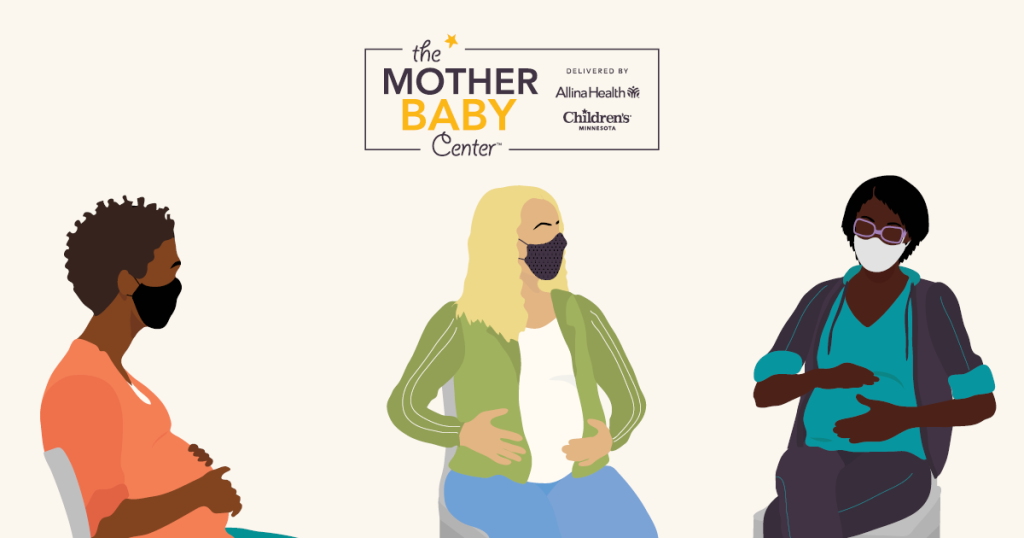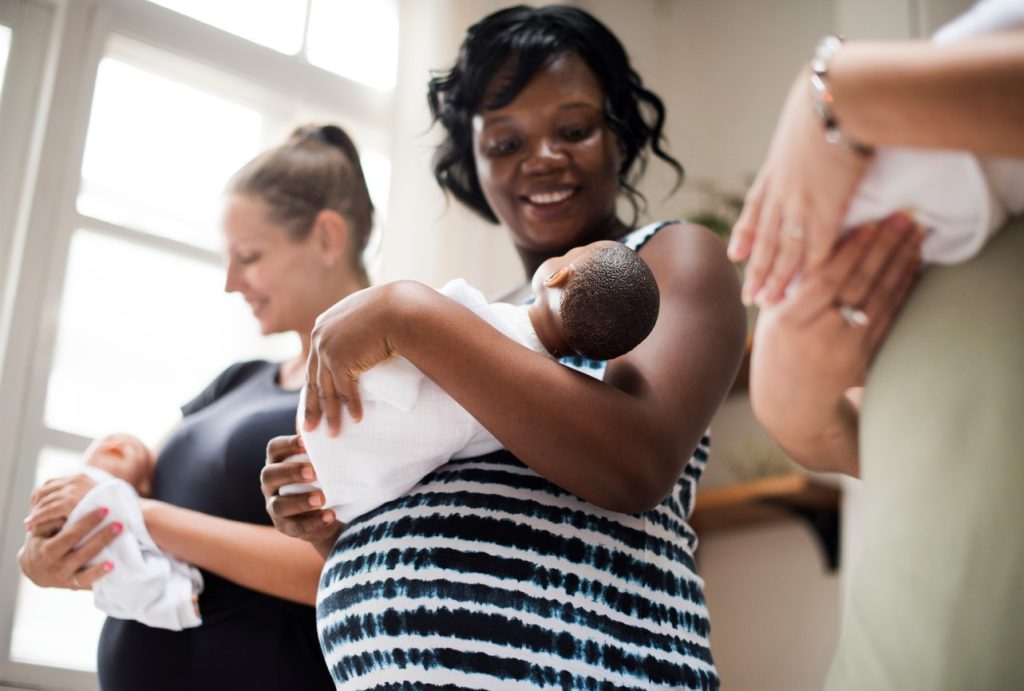Pregnancy books and blogs from trusted sources (like this one!) are great resources as you prepare for the arrival of your baby. After all, there’s a lot to know about your changing body, nutrition for you and your baby, and what to expect before, during and after the birth.
You’re on top of things, so you might also be wondering when to take birthing classes, and what is a Lamaze class? Here’s a pro tip: you don’t need to learn everything in the first few weeks of your pregnancy. In fact, you can hold off on childbirth classes until around the middle of the second trimester.
However, it’s okay to start reading up on types of birthing methods at any time. Knowing what to expect can help ease anxiety about your delivery from your first contraction to the final push.
Now’s a good time to start considering the best birthing classes for you, your partner, and your baby.
In this blog, we’ll cover all of those childbirth class questions and more. Taking birthing classes is the best way to know what the labor process looks like and what to expect with different types of birthing methods. Birthing classes often discuss the signs of labor, give you techniques for managing pain and teach you how to care for your baby during those first days.

Find the right delivery option for your family at The Mother Baby Center.
When is it time to take birthing classes?
As we’ve said, it’s never too early to learn about different types of birthing methods or caring for your baby. It’s great to feel prepared, have time to ask your questions and consider all of your options. That said, most doctors and midwives recommend taking birthing classes in the second trimester or early in the third trimester because you’re getting close to giving birth and things are starting to feel real, but it’s still early enough that you’re not rushed.
Early prenatal education classes often discuss the basics of labor and delivery, but they tend to focus more on nutrition, exercise, and fetal development. Generally, a childbirth class is taken in months 6 or 7 of your pregnancy.
If you’re taking a specific birthing class, it’s helpful to take the class closer to your due date so the information is fresh. In natural childbirth classes you learn breathing and other pain management techniques, so taking these classes in the second semester gives you time to practice what you’ve learned and maybe even adjust your birth plan. Other helpful pregnancy classes taken during your third trimester will focus on postpartum mother and baby care.
Are birthing classes necessary?
Are you required to take birthing classes or any classes for pregnancy? Nope, but the information and instruction provided in all prenatal education classes can be extremely helpful for you and your partner. Here are some things to consider:
- Labor and delivery can be unpredictable. Even the most carefully thought out birth plans can change at the last minute to keep you and your baby safe. Birthing classes will empower you with knowledge of how things work during labor and delivery, possible scenarios, and choices you can make during birth.
- Preparation reduces anxiety. Knowing how the body works during labor and delivery – and understanding what to expect – can make the experience less scary.
- Childbirth classes also help partners. It’s beneficial for partners or others who will be supporting you during birth to understand what will happen during labor and delivery. They can hear about your preferences, how to support you physically and emotionally, and advocate for you.
- Meet other parents-to-be. Many expectant parents say it’s wonderful to share their experiences with people they meet in pregnancy classes who are going through the same or similar things.
- Most childbirth classes include a tour of the birthing facilities. You might get the chance to have a look around the areas you’ll be giving birth, which can be helpful as you’re considering your labor and delivery preferences, or even what to pack.
- Relaxation techniques are helpful for all types of birth methods. All childbirth classes cover breathing, labor positions, and pain relief options that can be beneficial during labor and delivery.
- Understanding possible complications or interventions ahead of time can alleviate some fear if they are needed. The number one goal during labor and delivery is to keep the mother and baby safe. If interventions are needed, it can be chaotic so having a general understanding of things ahead of time can help ease anxiety about what’s happening.
- Feeling informed creates confidence. Having a good understanding of what to expect during your labor and delivery can help you have a more satisfying birth experience.
- Birthing classes also include how to care for your newborn baby. A birthing class for first-time parents is especially beneficial to learn about things like breastfeeding, how to soothe your baby, and caring for your baby’s body. Babies don’t come with an owner’s manual!
Should you take a specific class for your delivery?
If you already know the type of labor and delivery method you want, it will be beneficial to take a class specifically about that method. Some birthing methods have techniques and philosophies unique to them, so you’ll likely feel more informed by taking a specific class about your preferred method.
Remember, there is not just one “right” type of birthing method or class to take during pregnancy, and there are many different options to choose from. Consider talking to like-minded friends who have given birth and do your research about what’s available. Some expectant parents feel most comfortable taking birthing classes offered by their hospital. Others prefer the types of birthing classes offered by other pregnancy and childbirth centers.
The Mother Baby Center partners with three great Twin-cities-based organizations to offer a wide range of prenatal classes for pregnancy, labor and delivery, and newborn care.
Do you need birthing classes if it’s not your first child?
For better or worse, no two births are the same. Even if you’ve previously had a baby, each birth experience is unique, which can make the moments special. But that also means things can become unpredictable and unplanned during any labor and delivery. Birthing classes are almost always helpful, even if you’re a second (or third, or fourth) time parent-to-be.
It can be useful to get a refresher on the basics, and maybe learn some new techniques to improve your birthing experience over your previous birth(s). Meeting other parents-to-be is often one of the favorite parts of joining a childbirth class, and first-time parents will likely appreciate hearing about your experiences.
Feel prepared for delivery at The Mother Baby Center with birthing classes available to you.
Types of birthing classes
When it comes to preparing for your labor and delivery, there are choices galore! You might be the kind of person who finds this thrilling.
You probably also love to consider all 48 flavors of ice cream before deciding on the perfect double-scoop that will satisfy your pregnancy cravings. Or you might be the kind of person who wishes there were one or two types of birthing methods to consider because by now you’re exhausted from making so many decisions during pregnancy. You also choose chocolate ice cream every time.
Now everyone, breathe: We think we can help both kinds of parents-to-be with this overview of childbirth classes. And rest assured, you will make the right choice – because there are no wrong choices!
There are two primary categories: birthing classes that assume you’ll use pain medication and medical interventions, or unmedicated birth classes that prefer medical interventions only when necessary for the safety of you and your baby.
Here’s a list of the most common types of childbirth classes we’ll be explaining:
- The Lamaze Technique
- The Alexander Technique
- HypnoBirthing Method
- The Bradley Method
- Birthing From Within
The advice for choosing one is pretty simple: learn a little bit about each of them, then choose the one that sounds like it will fit you best. (And, you can change your mind!)
The Lamaze Technique
Lamaze is the oldest, most well-known birthing technique and one of the original natural birthing classes. The goal of Lamaze is to use relaxation and rhythmic breathing (remember “hee-hee-hoo”?) to get through childbirth without pain medication and minimal medical intervention. Coaching from your partner throughout the labor and delivery is also a focus of the Lamaze method.
If you’re planning to deliver with pain medication or if you could be induced, you might feel out of place in a class with a core goal of avoiding medical interventions. Lamaze classes do explain pain medication options, however, and learning the other relaxation techniques, different birthing positions, and how to use tools like birthing balls can be very helpful. It’s also very easy to find a Lamaze labor class taught live in person or online, or pre-recorded classes, so it can work well for busy schedules.

Expert care delivered at every stage of your pregnancy at all locations of The Mother Baby Center.
The Alexander Technique
The Alexander technique is a movement and relaxation method that uses gentle stretching to address pain and tension. The traditional Alexander technique, which is often used by actors and dancers to get the mind and body in sync, has been adapted for pregnancy to help with labor breathing and finding focus to make birth more comfortable.
You’ll learn to cope with pain through conscious control over your posture and movement. If you have aches and pains during pregnancy, this method might also offer some relief. (Make sure to check in with your doctor about unexplained pregnancy pains before starting any exercise or stretching program.)
The Alexander technique can be good for preparing your body for childbirth, but you might also want to take more traditional birthing classes to learn what happens during labor and delivery, medical interventions, postpartum care, etc.
Hypnobirthing Method
If you (or your partner) are anxious or fearful about childbirth, HypnoBirthing might be a good technique for you to explore. To some, HypnoBirthing, also called the Mongan Method, is a philosophy because it teaches you that severe pain does not have to be part of labor if you’re able to remove fear and anxiety by staying in a highly relaxed state.
The HypnoBirthing method assumes the labor and delivery will not use pain medications or unnecessary medical interventions. Instead, this method uses self-hypnosis techniques that help laboring women and their partners replace fear with positive messages, special breathing techniques, and meditation. In one study, 80% of mothers who had taken a HypnoBirthing labor class elected not to have an epidural.
Proponents of this method say the skills learned to support childbirth also help reduce discomfort, pain, and anxiety in other stressful situations.
The Bradley Method
Remember the example of the 48 flavors of ice cream person from above? If you think it’s impossible to be over-prepared, then this childbirth class option might be perfect for you.
The Bradley Method covers all aspects of childbirth, birth methods, medical interventions, relaxation techniques, infant care, and whatever else you’d like to talk about. It’s a 12-week course (so start it in your second trimester) and focuses on techniques to help you in all stages of labor.
This method also prepares parents-to-be for an unmedicated delivery] and is designed to help mothers accept pain as a natural part of the birthing process. It focuses on deep abdominal breathing and focusing attention inward (versus choosing an external “focal point” as in Lamaze). Partners are engaged equally and taught to be the “coach” during labor. According to a study, 86% of participants in the Bradley Method had a drug-free delivery.
The Bradley Method birthing class is a pretty big time commitment, but that also means you’ll cover a lot of information and probably get to know other like-minded parents.
Birthing From Within
If you’re the kind of person who likes to reflect on the emotional and psychological aspects of an experience, this could be the best pregnancy class for you. Birthing From Within was developed to explore your feelings, goals, and expectations about your pregnancy, birth and parenthood.
Birthing from Within birthing classes usually involves journaling, drawing, and other exercises to process your desires and fears related to childbirth. The exercises can be done in class or privately, which can be helpful for someone processing past trauma or fears. Birthing From Within touches on pain management techniques and birth preparation, so it might be helpful to also take a more traditional childbirth class.

How to choose which type of class to take
Hopefully, by now you’ve got some good ideas about your ideal birth experience. That’s a great place to start – what is your “ideal birth plan?”
Of course, you know there’s a chance things will not go exactly like your ideal birth plan. And that is okay because the number one goal during your labor and delivery is to keep you and your baby safe. That said, making choices now around your ideal birth plan will help you move toward the kind of birth experience you hope to have.
When it comes to choosing a birthing class, there are some things to keep in mind:
- All childbirth classes have this in common: They give parents-to-be information and tools that will make their birthing experience as positive as possible, for them.
- Make sure the philosophy or goal of the birthing class matches your expectations. There are widely different visions of an ideal birth experience, so make sure yours aligns with the class(es) you’re taking. Reach out to the instructor to learn if their views of birth match yours and those of your healthcare provider.
- Your doctor or midwife can be a good resource for recommending a childbirth class. You’re having regular conversations with them about your pregnancy, so they might be able to offer some good insights for classes that match your goals.
- Friends with babies or young kids can be a great resource for you. Find out what childbirth classes they took and if they have other helpful advice for you. Personal recommendations (or warnings) from like-minded people you trust are often extremely useful.
- Research the techniques and reflect on your preferences before you enroll in the class. If you know you want an epidural, it might not be worth your time to take a Bradley Method class. On the other hand, maybe you’re interested in exploring other pain management options, in which case taking the Bradley Method class could be a good idea for you.
- Classes taught in person will offer a different experience than online birthing classes. Hands-on learning can be really helpful for some people. Virtual classes can be more convenient for busy schedules. It can be harder to make friendships with other parents-to-be in virtual classes. There are pros and cons to both options.
- There is a wide range of costs for classes to take while pregnant. Some childbirth classes that run 10-12 weeks or longer can cost several hundreds of dollars. There are less expensive options for prenatal classes, including reduced rates and free. Online classes can also be a more affordable option.
- A comprehensive birthing class will cover the physical, psychological and emotional aspects of childbirth. A good course will review the stages of labor, options for pain medications, a discussion of possible medical interventions including C-sections, natural ways to reduce and cope with pain, newborn care, emotional support, and postpartum care.
- Depending on your needs and goals, it might be helpful to take a class on breastfeeding, infant CPR or infant first aid. If you have time, you (and your partner) might want to squeeze in these classes before your baby arrives.
The Mother Baby Center delivers expert care at every stage of pregnancy and delivery
We love that you trust us for advice on important pregnancy information like when to take childbirth classes. The Mother Baby Center is honored to be your partner during this very exciting time!
The Mother Baby Center is a collaboration between two of the best-known names in pregnancy and birth care: Allina Health and Children’s Minnesota. Allina Health also partners with three great Twin-cities-based organizations to offer a wide range of prenatal classes for pregnancy, labor and delivery, and newborn care.
As you get ready for your labor and delivery, we hope you will continue to let us support you and your unique set of needs for your ideal birth experience. Continue your planning now with a virtual tour of our birthing centers. We look forward to meeting you in person!